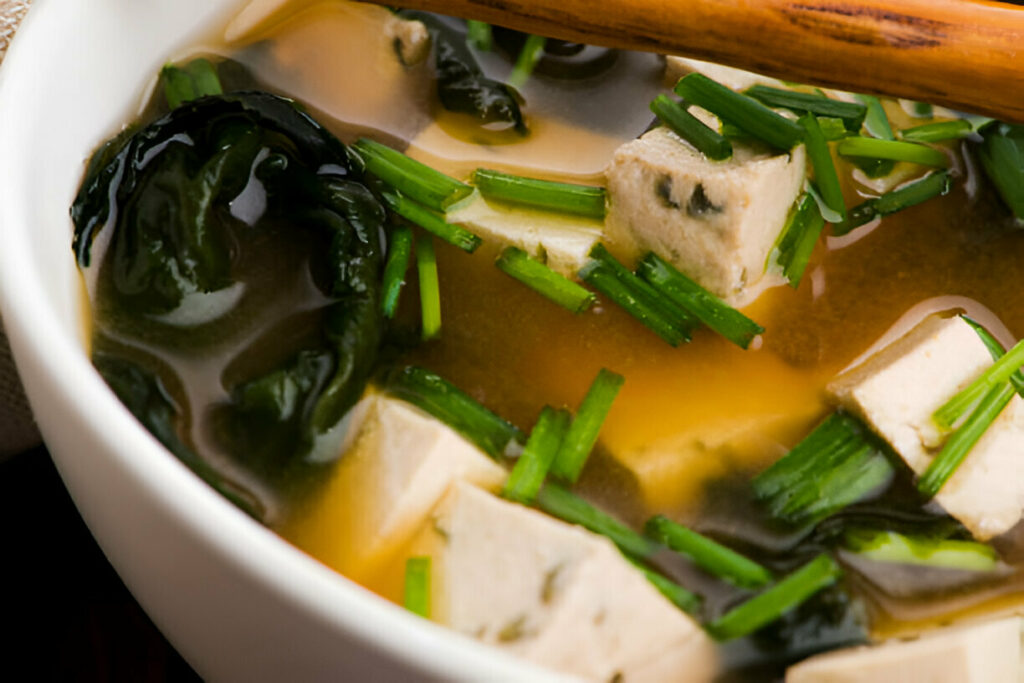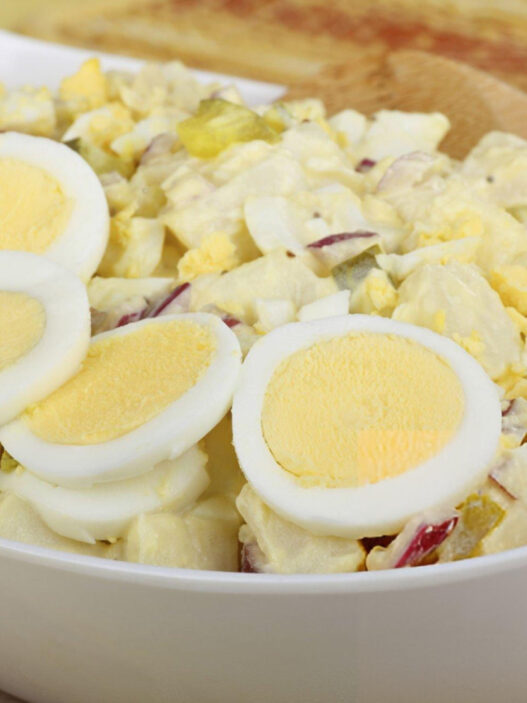Delicately savory and effortlessly soothing, Japanese Miso Soup is a timeless comfort enjoyed across all hours of the day. Whether it opens a meal or serves as a light, satisfying dish on its own, its warmth and simplicity make it a staple in Japanese cuisine.

Ingredients Breakdown
The soul of miso soup lies in dashi, the broth built on kombu and bonito flakes. Kombu, or dried kelp, imparts a subtle earthy base, while bonito flakes—shaved, smoked skipjack tuna—add a smoky, fish-forward complexity that defines the character of the soup. Once infused into water, these ingredients create a golden, clear broth that acts as the canvas for everything that follows.
Yellow miso paste, often made with fermented soybeans and rice, brings a mellow saltiness and mild sweetness. Opting for a reduced-sodium version gives you more flexibility to adjust flavors to your liking without overpowering the broth.
Silken tofu, soft and custard-like, complements the richness of the dashi with its creamy texture. It’s essential to use gentle handling when cutting it into bite-sized cubes, as it tends to be fragile. Firm tofu, while easier to manage, lacks the soft mouthfeel that makes this dish so comforting.
Dried wakame, a type of edible seaweed, rehydrates quickly and offers a smooth, slightly slippery texture along with a whisper of briny flavor. Finely chopped green onions provide a touch of freshness and color when used as garnish.
Step-by-Step Preparation Guide
Start by preparing the tofu, carefully draining it and slicing it into small, uniform cubes—about 1.5 cm each side. This size ensures even heating and a pleasing texture in each bite.
To build the base broth, place kombu and bonito flakes into a saucepan filled with cold water. Slowly bring this mixture to a boil, allowing the kelp and flakes to infuse the liquid with umami. As soon as it begins to boil, remove the kombu promptly. Leaving it in too long can result in a bitter taste that throws off the balance of the soup.
Lower the heat to a gentle simmer and let the broth continue to develop for five minutes. During this time, prepare a fine sieve lined with a clean paper towel. This setup allows you to strain the broth thoroughly, ensuring that no stray flakes cloud the dashi. Once strained, pour the clarified broth back into the pot.
Place the pot over medium heat and whisk in the miso paste gradually. A whisk breaks down the paste more efficiently, helping it integrate into the broth without leaving clumps. Avoid boiling the soup after this step, as high heat can degrade the delicate flavor of the miso.
Stir in the dried wakame seaweed and let it expand. It softens almost instantly and floats gracefully in the broth. Gently slide in the tofu cubes, allowing them to warm through without breaking apart. A final touch of chopped green onions right before serving adds brightness and contrast.

Recipe Tips
How to prevent bitterness by timing kombu removal:
Take out the kombu as soon as the water reaches a boil to avoid overpowering the broth with astringency.
Best way to dissolve miso without clumps:
Use a small whisk or mesh strainer to blend the miso smoothly into warm (not boiling) broth.
Adjusting miso levels to control saltiness:
Start with less miso and taste as you go. Add more gradually until you find the right depth.
Handling tofu to keep it intact in the soup:
Use a wide spoon or ladle to transfer tofu cubes and stir gently only when necessary.
What to Serve With This Recipe
Miso soup pairs wonderfully with a bowl of steamed Japanese short-grain rice and grilled fish like mackerel or salmon. Pickled vegetables, such as tsukemono, balance the soup’s savory depth with acidity and crunch.
For breakfast, enjoy it with tamagoyaki (Japanese rolled omelet) and a side of rice. It’s light yet satisfying—an ideal start to the day. For lunch or dinner, combine with sushi rolls or onigiri for a filling yet refreshing meal that highlights clean, simple flavors.
Creative Variations
To add heartiness, include thinly sliced shiitake mushrooms or daikon radish. These absorb the broth and bring additional textures to the dish.
You can swap wakame for other seaweeds like hijiki or shredded nori for a different bite. Try experimenting with red miso for a stronger, earthier flavor, or white miso for a lighter, sweeter finish depending on your preference or the season.
Frequently Asked Questions
Can I make this soup ahead of time?
Yes. Prepare the dashi and store it refrigerated for up to 3 days. Add miso and tofu just before serving for best results.
How long does dashi last in the fridge?
Dashi can be stored in an airtight container in the refrigerator for up to 3 days.
What’s the best substitute if I don’t have bonito flakes?
For a vegetarian version, replace bonito flakes with dried shiitake mushrooms or use kombu alone for a lighter dashi.
Can I make this vegetarian or vegan?
Absolutely. Omit the bonito flakes and use only kombu, or add dried mushrooms for more umami.
Should I boil the miso soup after adding miso paste?
No. Boiling miso can dull its flavor and affect its nutritional properties. Always heat gently after adding miso.
This miso soup offers more than a warm bowl—it delivers a moment of quiet satisfaction with every sip. Its clean, umami-rich broth, delicate tofu, and whisper of seaweed create a dish that’s both nourishing and refined.
With minimal ingredients and gentle cooking techniques, it’s a recipe that fits effortlessly into any mealtime. Whether you’re starting the day or winding it down, a bowl of this Japanese miso soup brings comfort and calm in its purest form.

Ingredients
2¼ cups cold water
4 pieces kombu (dried kelp)
⅓ cup bonito flakes (smoked skipjack tuna flakes)
2 tablespoons reduced-sodium yellow miso paste
0.10 oz dried wakame seaweed
2.85 oz soft or silken tofu
½ green onion, finely chopped (optional garnish)
Instructions
Begin by draining any excess liquid from the soft tofu with care. Handle it gently to maintain its delicate texture. Once drained, use a sharp knife to cut the tofu into small cubes, approximately 1.5 cm on each side. Keeping the tofu pieces small ensures a more pleasant texture in the soup.
In a small saucepan, combine the cold water, kombu, and bonito flakes. Set the pot over medium-high heat and bring it to a boil, uncovered. As soon as the liquid reaches a boil, promptly remove the kombu to prevent it from imparting an overly bitter taste to the broth.
Reduce the heat to the lowest setting, cover the pot, and let the mixture simmer gently for five minutes. Meanwhile, prepare a straining setup by placing a clean paper towel inside a fine mesh sieve and resting it over a large bowl or measuring cup.
After simmering, pour the broth through the paper towel-lined sieve to remove all the bonito flakes. This creates a clear, flavorful dashi base. Return the strained broth to the saucepan.
Place the pot over medium heat and whisk in the miso paste, ensuring it dissolves fully into the broth. Whisking helps break down the paste quickly and evenly. Once the miso is fully incorporated, stir in the dried wakame seaweed and allow it to rehydrate and bloom.
Finally, gently add the cubed tofu to the soup. Let everything heat through briefly, being careful not to boil. Serve warm, garnished with finely chopped green onions if desired.

Japanese Miso Soup Filled with Kelp Recipe
Ingredients
- 2¼ cups cold water
- 4 pieces kombu dried kelp
- ⅓ cup bonito flakes smoked skipjack tuna flakes
- 2 tablespoons reduced-sodium yellow miso paste
- 0.10 oz dried wakame seaweed
- 2.85 oz soft or silken tofu
- ½ green onion finely chopped (optional garnish)
Instructions
- Begin by draining any excess liquid from the soft tofu with care. Handle it gently to maintain its delicate texture. Once drained, use a sharp knife to cut the tofu into small cubes, approximately 1.5 cm on each side. Keeping the tofu pieces small ensures a more pleasant texture in the soup.
- In a small saucepan, combine the cold water, kombu, and bonito flakes. Set the pot over medium-high heat and bring it to a boil, uncovered. As soon as the liquid reaches a boil, promptly remove the kombu to prevent it from imparting an overly bitter taste to the broth.
- Reduce the heat to the lowest setting, cover the pot, and let the mixture simmer gently for five minutes. Meanwhile, prepare a straining setup by placing a clean paper towel inside a fine mesh sieve and resting it over a large bowl or measuring cup.
- After simmering, pour the broth through the paper towel-lined sieve to remove all the bonito flakes. This creates a clear, flavorful dashi base. Return the strained broth to the saucepan.
- Place the pot over medium heat and whisk in the miso paste, ensuring it dissolves fully into the broth. Whisking helps break down the paste quickly and evenly. Once the miso is fully incorporated, stir in the dried wakame seaweed and allow it to rehydrate and bloom.
- Finally, gently add the cubed tofu to the soup. Let everything heat through briefly, being careful not to boil. Serve warm, garnished with finely chopped green onions if desired.


















